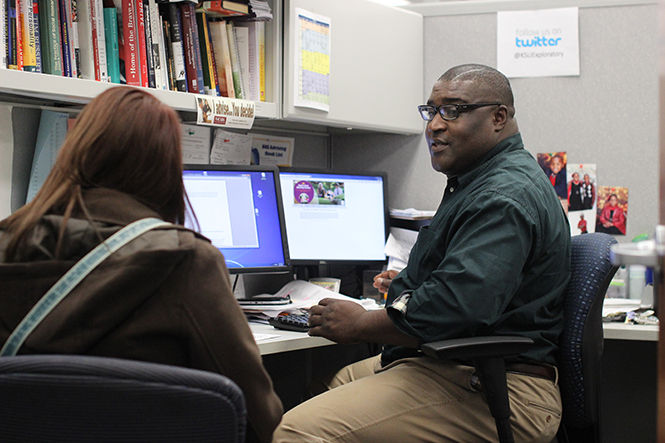Students face difficulties scheduling
Academic advisor H. Bate Agbor-Baiyee discusses scheduling with a student during an advising appointment on the 5th floor of the Kent State Library on Nov. 13, 2014.
April 23, 2015
With scheduling for next fall semester in full swing, many Kent State students face difficulties getting into certain classes.
Hallee Borchart, a sophomore fashion merchandising major, said she is one of many fashion majors who have trouble scheduling for classes needed in her major sequence.
“I’ve been having a problem this year with my one class and it has three spots open but each class only holds 30 people,” Borchart said. “By the time I went to schedule for my junior year, they were already all closed.”
Borchart is one of an estimated 950 fashion merchandising majors along with a total of 1,573 students in the fashion program at Kent State, according to 15th day data from the university.
Borchart said she has been shut out of fashion courses because of her class standing multiple times.
“Since I was a sophomore they couldn’t really get me in there as much as the juniors or seniors needed to be,” Borchart said.
Meleah Hansen, a sophomore integrated health studies major, said it’s frustrating being a sophomore because she schedules later than juniors and seniors.
“It’s awkward because you have to wait until 12:01 a.m. with your schedule you hope to get into and by the time you go in, everyone in your specific credit group is going all at once,” Hansen said.
Having a requirement to meet with an advisor each semester before scheduling has also put a burden on Hansen, she said. She, like many other students, sometimes has to wait up to a week to schedule an appointment with their advisor.
Steven Antalvari, the director of University Advising, said many factors go into forecasting classes for upcoming semesters that can vary by department. Some programs can be more technical and others can be more general, Antalvari said.
“Someone in every department will look at how many students are in the program, where they fall and when they should be offering sections of classes,” Antalvari said.
Advising and departments, however, will make exceptions if the student needs a class that is critical to maintaining their major sequence, Antalvari said.
“No department is going to prohibit a student from taking a class that’s going to keep them on track on a four-year plan if they’ve done everything they’re supposed to do,” Antalvari said.
The advising office is also currently working on ways to market to each class to make sure they see their advisor before their time to schedule. Antalvari said the office is also attempting to create more availability for advising appointments but students should plan in advance.
“We don’t want to stand in your way of graduating on time if you’re doing everything you’re supposed to be doing,” Antalvari said.
Accreditation also plays a factor in forecasting classes.
With more than 1,000 students in the Journalism and Mass Communication (JMC) program within the College of Communication and Information (CCI), class sizes tend to be limited.
Danielle Coombs, the associate director of JMC, said the school’s accreditation determines the amount of students that can be placed in certain classes.
“Based on our accreditation, no skills classes can have more than 20,” Coombs said. “No matter how much we want to be able to up the numbers in those classes we can’t because we can’t lose our accreditation over that.”
Coombs said the department will be announcing new curricula in journalism and advertising next fall semester and has given them a chance to review how they forecast classes. This includes a new updated waitlist process specifically implemented by JMC.
“Instead of using the university waitlist through the registration system, what we’ve done is our scheduler, Jessica Cordier, has created a system where we use GoogleDocs,” Coombs said. “Students can register and explain why they need the class and then they submit that so we have a list.”
Coombs said she hopes the waitlist will be successful and will branch out to other schools on campus and that it will help the school be more proactive in forecasting classes.
Other programs such as the School of Digital Sciences pulls courses from multiple colleges, making forecasting classes a high priority.
Robert Walker, the director of the school, said the interdisciplinary program has grown tremendously since its beginning in Fall 2011. According to Walker, there are currently 175 undergraduate students and 325 graduate students, making it the largest onsite masters program at Kent State.
The school is very data-driven when it comes to forecasting for classes and includes a lot of analysis, Walker said.
“After the fifteenth day of the semester, we look through every one of our students and build a big spreadsheet of what classes they have taken so far then we predict what they are going to take the next semester,” Walker said.
Since the school draws courses from other programs, Walker is in constant contact with other departments to make sure his students are reserved spots in those courses.
“I have to tell the other programs how many students I am going to put in their classes because they’re also doing this for their students,” Walker said. “If I don’t do this and then suddenly I drop 50 students in there, they will not have a plan for that.”
Walker is planning for an estimated 250 students for the fall semester and is looking forward to watching the program expand.
As students are planning for next semester, Antalvari concludes with some advice: “See your advisor early because then you can register on time and most likely get that class.”
Contact Kate Schwanke at [email protected].

























